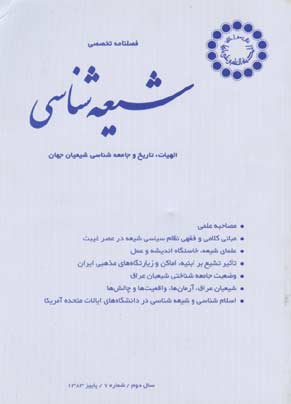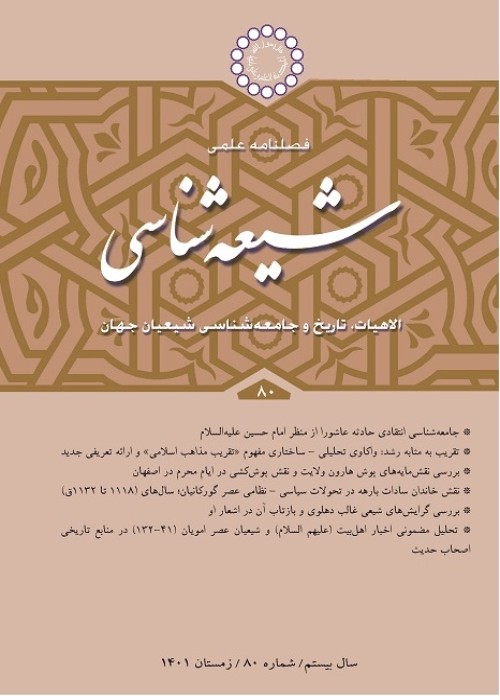فهرست مطالب

فصلنامه شیعه شناسی
پیاپی 7 (پاییز 1383)
- 256 صفحه، بهای روی جلد: 7,500ريال
- تاریخ انتشار: 1383/09/10
- تعداد عناوین: 11
- مصاحبه
-
صفحه 3مسلما در دین اسلام، اندیشه اجتماعی وجود دارد. با مقایسه اندیشه جامعه شناسان با اندیشه های اجتماعی دین، اولا آگاهی ما نسبت به دین بیشترمی شود; ثانیا، صحت و سقم گزاره های جامعه شناختی به محک دینی آزمون می گردند و در صورت عدم هماهنگی، ما به تامل وادار می شویم. وجود گزاره های جامعه شناختی در دین بستگی به تعریف ما از گزاره جامعه شناختی دارد. اگر ملاک جامعه شناختی بودن گزاره را دست یابی به آن گزاره از طریق تجربه بدانیم گزاره جامعه شناختی در دین نخواهیم داشت، ولی به نظر می رسد منشا گزاره ملاک نیست، بلکه آزمون پذیری ملاک است و گزاره های اجتماعی زیادی در قرآن و نهج البلاغه وجود دارند که آزمون پذیر هستند. بدین معنا، جامعه شناسی دینی خواهیم داشت.
- مقالات
-
صفحه 27دوره غیبت به دلیل فقدان حضور معصوم در جامعه برای شیعیان، دوره نقصان و حرمان تلقی می شود. از این رو، یکی از مهم ترین مسائل پیش روی شیعیان در این دوره، مسئله «حق حاکمیت» و مبانی نظام سیاسی و دولت است. عمده ترین مباحث در باب مبانی نظام سیاسی شیعه در دو حوزه کلامی و فقهی طرح شده است. این مبانی به طور عمده، از سوی کسانی طرح و بسط یافته اند که قایل به نظریه دولت مبتنی بر آموزه «ولایت فقیه» درعصر غیبت هستند. نوشته حاضر درآمدی بر طرح بحث درباره مبانی کلامی و فقهی نظام سیاسی شیعه در عصر غیبت، مبتنی بر آموزه «ولایت فقیه» است.
-
صفحه 39بررسی و شناسایی ویژگی های منفی برخی از آثار کهن و مشهور دانش فرقه شناسی موضوع این نوشتار است. نویسنده به منظور آسیب شناسی ومعرفی کاستی های گزارش این آثار درباره شیعه و فرقه های شیعی، به معرفی اجمالی هر یک از آن ها پرداخته، جهت گیری های خاص صاحبان آن هارا درباره شیعه و تشیع روشن می سازد. اختلاف ارباب ملل و نحل در اسامی و القاب فرقه های شیعی و شمارش افراطی آن ها از دسته بندی شیعیان وعوامل اصلی این اختلافات از جمله کاستی ها و مباحث مهمی است که مورد اهتمام نویسنده واقع شده. پیام اصلی نویسنده بر این نکته استوار است که پژوهش در تاریخ و اندیشه های شیعه و گروه های شیعی با تکیه صرف بر این آثار، نه تنهاپژوهشی ناقص و غیرقابل پذیرش است، بلکه موجب سردرگمی بیشتر خوانندگان خواهد شد.
-
صفحه 77هدف این مقاله آشنایی اجمالی خوانندگان محترم با شرح حال و چگونگی حیات علمی «عالمان شیعه» است. از این رو، بخش پژوهش مؤسسه شیعه شناسی در هر شماره تعدادی از بزرگان شیعه را معرفی می نماید. در این قسمت، تعدادی از عالمان شیعی به اختصار معرفی شده اند.
-
صفحه 97مقاله حاضر با نقد و بررسی نظریه های جامعه شناسی معرفت، درصدد تبیین خاستگاه اختلاف دراندیشه و عمل عالمان شیعه برآمده است. نگارنده با تقسیم مؤلفه های تاثیرگذار به (1) اختلاف های ناشی از اختلاف در منابع فقهی، (2) تاثیرزمان و مکان، (3) اختلاف های ناشی از عوامل جامعه شناختی، به این نتیجه رسیده است که انسان ها در یک بستر طبیعی (نظام علت و معلول و عالم اسباب) به دنیا می آیند، فقی هان و عالمان دینی نیز از این فرایندمستثنا نیستند. بدین روی، نقش عوامل مزبور، در اختلاف آراء و عمل علمای شیعه قابل انکار نیست.
-
صفحه 121در این مقاله، تاثیر تشیع بر ابنیه و اماکن مذهبی ایران مورد بررسی قرار گرفته است. تشیع نه تنها بر نوع معماری و آزین بندی اماکن موجود اسلامی همچون مساجد تاثیر گذاشته، بلکه در ایجاد انواع دیگری ازاماکن مذهبی همچون حسینیه، تکیه، سقاخانه، سقانفار / سقاتالار، آب انبار، امام زاده و زورخانه نیزتاثیرگذار بوده و نمادهای مذهبی به وضوح در این گونه اماکن تبلور یافته اند.
-
صفحه 147جنبش های اسلامی معاصر در روند تحولات منطقه خاورمیانه از جایگاه ویژه ای برخوردارند. در این میان، جنبش شیعیان عراق و بخصوص محورهای اساسی آن به مثابه گروه ها، تشکل ها و اشخاص مستقل معارض، در تقابل با نظام بعثی و تعامل در فرآیند کنونی دولت سازی عراق، از نقش قابل توجهی برخوردارند. این نوشتار در پی پاسخ به این سؤال است که «گروه های شیعی در ساختار جامعه شناسی سیاسی عراق در چه جایگاهی ایفای نقش می نمایند؟» در این زمینه، با اشاره به وجود شکاف مذهبی درعراق، روند تطور تاریخی، اصول، اهداف و اساسا رهیافت های نظری، رویکردهای عینی این گروه ها شامل «جماعت العلماء»، «حزب الدعوه»، «سازمان عمل اسلامی»، «مجلس اعلا» و رویکردهای نوین موسوم به «صدریون ثانی» و تنی چند از مراجع و علما مانند سیستانی، سیدکاظم حائری و مقتدی صدر دراین مقاله، تبیین و تحلیل شده اند.
- سخنرانی
-
صفحه 187آنچه در پی می آید حاصل سخنرانی جناب آقای علی اصغر محمدی، در مؤسسه شیعه شناسی می باشد که به تاریخ 21/3/83 در قم ایراد شده است.
- گزارش
-
صفحه 221آنچه پیش رو دارید گزارش مختصری از سفر حضرت حجه الاسلام والمسلمین دکترمحمود تقی زاده داوری، رئیس محترم «مؤسسه شیعه شناسی»، به کابل برای بررسی پروژه در حال تدوین «شیعیان افغانستان» می باشد.
-
صفحه 243
-
Page 3There is no doubt that a social doctrine can be identified in Islam. A comparative study of sociological theories and the Islamic social approach provides us with a better understanding of Islamic teachings. It also enables us to verify or falsify sociological theories on the basis of religious criteria. Moreover, discovering any inconsistency between sociological theories and the Islamic social doctrine provokes our thought. The question of whether sociological statements can be found in Islamic texts is contingent on how we define such statements. If sociological statements are merely those that are found out through empirical methods, there is no such statement in the Qur’ān and Nahj al-Balāghah (the collection of Imam ‘Ali’s lectures). However, it is the verifiability rather than the method of exploring of a statement that determines whether it is sociological or not. If this is the case, Islamic texts contain many sociological statements; and hence, we can talk about a religious sociology
-
Page 27For the Shi‛a, the era of occultation, when no infallible Imam is present in society, is considered as an era of loss and defectiveness. In such an era, the state and its legitimacy are important issues to be addressed. Shi‛ite theology and fiqh have extensively dealt with this issue. This article examines the view put forward by the advocates of velayat-e faqih, that is, the political authority of a leading religious scholar, in the era of occultation.
-
Page 39This article aims at investigating and understanding the negative aspects of a number of ancient and famous writings about the Shi‘ī sects and denominations. To show the shortcomings and deficiencies of the reports of these writings about Shi‛ism and Shi‛ite sects, the author briefly introduces these sources and clarifies the particular orientations of the compilers of these writings on Shi‛ism. He further illuminates the disagreements of these authors.The writer goes on to deal with the discrepancy of the authors of reports as to the various names given to the Shi‛ite sects and their extreme numeration of Shi‛ite groupings as well as the chief causes of their disagreements, including the mentioned above shortcomings.The main message of the writer is grounded in the fact that nay research into the history of Shi‛ism and its various sects by appealing only to these works will not only be incomplete and unacceptable, but also will further confuse the readers.
-
Page 77As part of the continued efforts of the journal to introduce some Shi‛ite scholars in each issue, this article provides brief biographies and short accounts of the intellectual lives of several Shi‛ite scholars. Some of the Shi‛ite scholars are briefly introduced in this volume.
-
Page 97This article is intended to explore the roots of differences, whether in theory or in practice, among the Shi‛ite ‘ulama. Critically examining various theories of the sociology of knowledge, the author recognises three categories of factors giving rise to such differences. These factors are: (1) references to different sources of fiqh, (2) geographical as well as temporal particularities, and (3) sociological factors.
-
Page 121In this article, it is examined how the Shi‛ite faith has influenced the architecture as well as decoration of certain public buildings, whether religious ones such as mosques, shrines and mourning places for Imam Husayn [Husaynīyya], or secular ones like traditional gymnasiums [zūrkhāneh] and public drinking places [saqākhāne], in Iran. Religious symbols can easily be identified in such buildings.
-
Page 147Islamic movements have played an important role in the political developments of the Middle East in recent decades. In Iraq, the Shi‛ite movement, in particular, has been active in opposing the former dictator, and in the so-called process of nation-building after the overthrow of Saddam Hossein. This paper is concerned with the place of Shi‛ite groups in Iraq, from the perspective of political sociology. Given the religious divide in Iraq, the goals, principles, theoretical as well as practical approaches and developments of Shi‛ite groups, such as the Society of the ‘Ulama [Jamā‛at al-‘Ulama], the Da‛wa Party [Hizb ad-Da‛wa], the Supreme Council for Islamic Revolution in Iraq [Majlis al-‘Alā] and the Organisation for Islamic Action [Monazzamat al-‘Amal al-Islami] are considered. The views of some important Shi‛ite figures, such as Ayatollah Sīstānī, Ayatollah Seyyed Kāzim Hā’irī and Moqtadā Sadr are also analysed in this paper.


